He is at the center of history’s most controversial Star Wars moment. He was beat up by Anakin Skywalker. He is a legendary failure. He is Greedo the Young.
Greedo
From his appearance, blaster in hand, in Episode IV: A New Hope![]() , Greedo the bounty hunter became the Star Wars symbol of feckless overconfidence at a near Shakespearean level. He’s shot dead in the middle of a speech about his superior skill and luck, then is defeated at every other appearance in flashbacks on his life.
, Greedo the bounty hunter became the Star Wars symbol of feckless overconfidence at a near Shakespearean level. He’s shot dead in the middle of a speech about his superior skill and luck, then is defeated at every other appearance in flashbacks on his life.
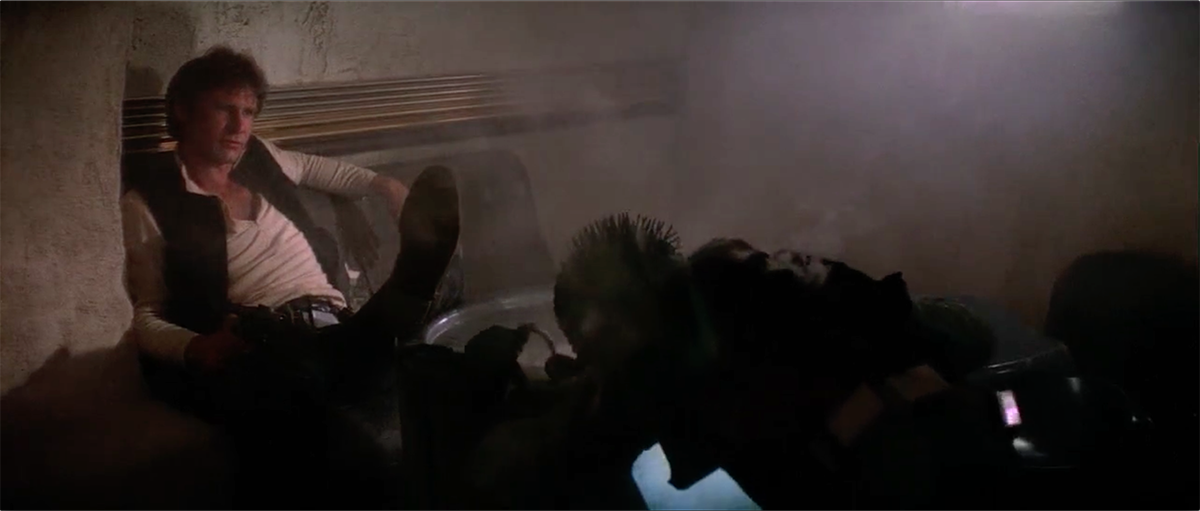
In a deleted scene from Episode I: The Phantom Menace![]() , a young Greedo is beat up by Anakin Skywalker after accusing the human boy of cheating to achieve his victory at the Boonta Eve Classic Podrace. (Watch the scene on YouTube.) Greedo is defeated before ever taking a swing—at Skywalker or Solo. In the theatrical release of A New Hope, Han Solo shoots Greedo before the hapless bounty hunter can get off a shot. Although Lucas would later change the altercation multiple times in the 1997 Special Edition, 2004 Trilogy DVD box set, and the 2011 The Complete Saga Blu-ray releases of A New Hope, most fans consider the theatrical release definitive, thus proving empirically that Greedo was killed without returning fire. His death is thrice foreshadowed by the one-sided brawl in The Phantom Menace. First, Greedo’s mouth initiates both the quarrel with Skywalker and the one with Solo, while it’s his opponents who end their respective altercations. Next is the fact that Greedo is never shown to strike Anakin; with Anakin atop him, Greedo is punched but merely struggles ineffectually rather than returning with a shot of his own. The final foreshadowing is more obvious and direct. After the fracas with Skywalker is ended, fellow Rodian child, Ward, admonishes young Greedo that he should “be careful who [he messes] with,” that he will “come to regret it.” Thirty years later, in a dirty corner of Chalmun’s Cantina at the Mos Eisley spaceport, Greedo demonstrates a failure to learn the childhood lesson and suffers the final consequence of that deficiency. Those two aren’t the only occasions on which we see Greedo’s overconfidence and ineptitude.
, a young Greedo is beat up by Anakin Skywalker after accusing the human boy of cheating to achieve his victory at the Boonta Eve Classic Podrace. (Watch the scene on YouTube.) Greedo is defeated before ever taking a swing—at Skywalker or Solo. In the theatrical release of A New Hope, Han Solo shoots Greedo before the hapless bounty hunter can get off a shot. Although Lucas would later change the altercation multiple times in the 1997 Special Edition, 2004 Trilogy DVD box set, and the 2011 The Complete Saga Blu-ray releases of A New Hope, most fans consider the theatrical release definitive, thus proving empirically that Greedo was killed without returning fire. His death is thrice foreshadowed by the one-sided brawl in The Phantom Menace. First, Greedo’s mouth initiates both the quarrel with Skywalker and the one with Solo, while it’s his opponents who end their respective altercations. Next is the fact that Greedo is never shown to strike Anakin; with Anakin atop him, Greedo is punched but merely struggles ineffectually rather than returning with a shot of his own. The final foreshadowing is more obvious and direct. After the fracas with Skywalker is ended, fellow Rodian child, Ward, admonishes young Greedo that he should “be careful who [he messes] with,” that he will “come to regret it.” Thirty years later, in a dirty corner of Chalmun’s Cantina at the Mos Eisley spaceport, Greedo demonstrates a failure to learn the childhood lesson and suffers the final consequence of that deficiency. Those two aren’t the only occasions on which we see Greedo’s overconfidence and ineptitude.

During the Clone Wars, as chronicled by the animated television show Star Wars: The Clone Wars![]() , Greedo works as a bounty hunter in the employ of Jabba the Hutt—the same vocation and patron as when we later meet him in A New Hope. In the episode titled “Sphere of Influence,” the Trade Federation engages Greedo and a team of associates to kidnap the daughters of Pantora planetary Chairman Papanoida, the character whom George Lucas himself portrays in a cameo appearance in Episode III: Revenge of the Sith
, Greedo works as a bounty hunter in the employ of Jabba the Hutt—the same vocation and patron as when we later meet him in A New Hope. In the episode titled “Sphere of Influence,” the Trade Federation engages Greedo and a team of associates to kidnap the daughters of Pantora planetary Chairman Papanoida, the character whom George Lucas himself portrays in a cameo appearance in Episode III: Revenge of the Sith![]() . The Trade Federation hopes to use the abduction as leverage sufficient to force Papanoida to commit Pantora to membership in the Confederacy of Independent Systems (CIS). Greedo’s ineptitude causes him to be instantly found out, and his cowardice before Chairman Papanoida and Jabba the Hutt sees him readily admit culpability. He then leads Papanoida to where his associates are holding the kidnapped daughters. The confrontation results in a blaster fight, with Greedo cowering behind an overturned table in the same cantina in which Solo would later kill him. Because of Greedo’s overconfidence and pusillanimity, the Trade Federation’s plan backfires, ultimately strengthening Pantora’s membership in the Republic and removing the trade embargo previously levied against the planet by the Trade Federation.
. The Trade Federation hopes to use the abduction as leverage sufficient to force Papanoida to commit Pantora to membership in the Confederacy of Independent Systems (CIS). Greedo’s ineptitude causes him to be instantly found out, and his cowardice before Chairman Papanoida and Jabba the Hutt sees him readily admit culpability. He then leads Papanoida to where his associates are holding the kidnapped daughters. The confrontation results in a blaster fight, with Greedo cowering behind an overturned table in the same cantina in which Solo would later kill him. Because of Greedo’s overconfidence and pusillanimity, the Trade Federation’s plan backfires, ultimately strengthening Pantora’s membership in the Republic and removing the trade embargo previously levied against the planet by the Trade Federation.
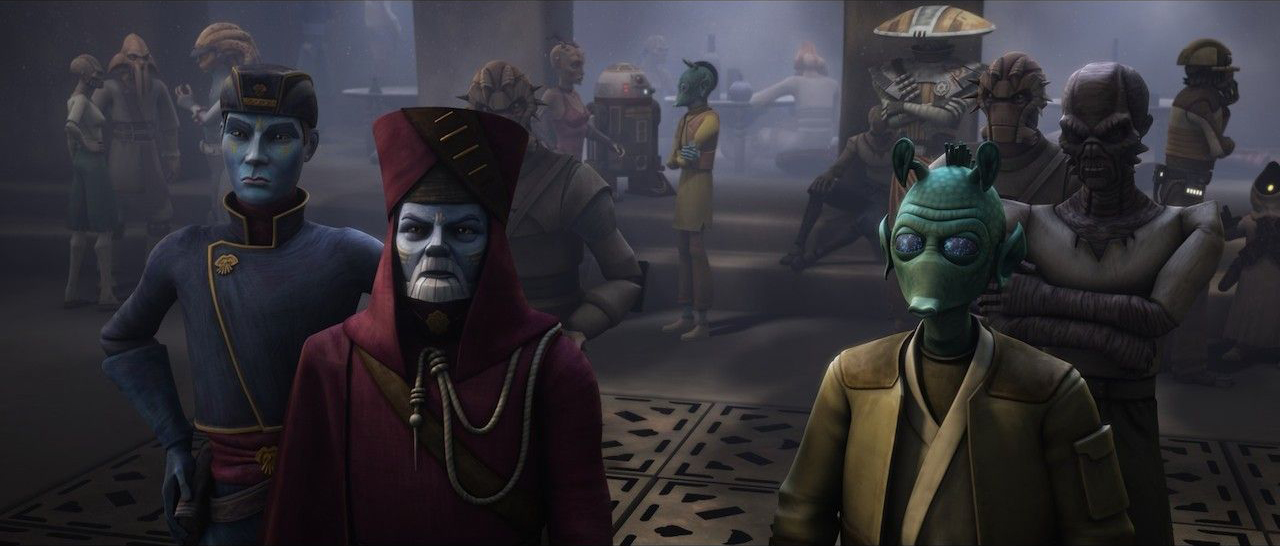
Behind the scenes, the green-skinned Rodian is just as luckless.
Two actors portray Greedo in A New Hope. Paul Blake is the actor in the costume and simple rubber mask during the majority of the scene in which Greedo confronts Solo, while actress Mara De Aragon dons a more advanced, animatronic-infused mask during the close-up shots. De Aragon’s mask is fitted with wires and articulators to affect the movements of Greedo’s ears, antennae, and mouth. Unfortunately, just before filming begins, the mouth animatronics malfunction irreparably. At the behest of George Lucas, the actress then manipulates Greedo’s elongated mouth by using a wooden clothespin held between her teeth. The final footage of the clothespin-articulated snout remains in all editions of the film. The mask, with its attendant armatures, wires, tape, and padding, leaves little room for De Aragon to breathe, and, during one period of prolonged setup, rehearsal, and shooting, she finds that she can’t, in fact, draw a breath—nor can she remove the mask herself because of the clumsiness of the costume’s gloves. Fortunately, she manages to gesticulate to Lucas, alerting him to her predicament; Lucas removes the mask, and grants De Aragon more frequent breaks from wearing it during filming.
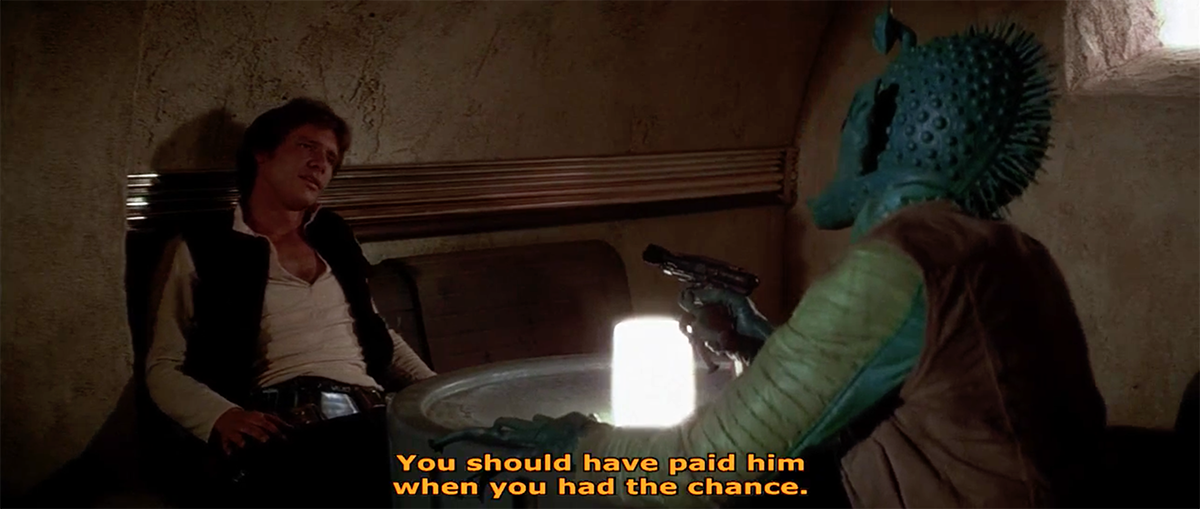
As cumbersome as the Greedo costume is, it was nearly a very different design. Early sketches for the character first have him as four-armed and then two-armed but hirsute and betailed.
Beyond film and animation, Greedo receives a little more, though no more heroic, attention. He appears, or is mentioned in, several comics and graphic novels from Dark Horse Comics, including Episode I: Qui-Gon Jinn![]() and Underworld: The Yavin Vassilika
and Underworld: The Yavin Vassilika![]() . As a prominent character in the Cantina Scene, Greedo is naturally included among the character vignettes in The Mos Eisley Cantina Pop-Up Book
. As a prominent character in the Cantina Scene, Greedo is naturally included among the character vignettes in The Mos Eisley Cantina Pop-Up Book![]() .
.
The largest non-Canon appearance of Greedo is in the never-was-Canon anthology Tales from the Mos Eisley Cantina![]() . As the short stories focus on the backgrounds and adventures of a number of patrons present in Chalmun’s Cantina that fateful day when Skywalker met Solo and Solo killed Greedo, Greedo is mentioned or factors into several tales. He stars in “A Hunter’s Fate: Greedo’s Tale,” written by Tom and Marth Veitch.
. As the short stories focus on the backgrounds and adventures of a number of patrons present in Chalmun’s Cantina that fateful day when Skywalker met Solo and Solo killed Greedo, Greedo is mentioned or factors into several tales. He stars in “A Hunter’s Fate: Greedo’s Tale,” written by Tom and Marth Veitch.
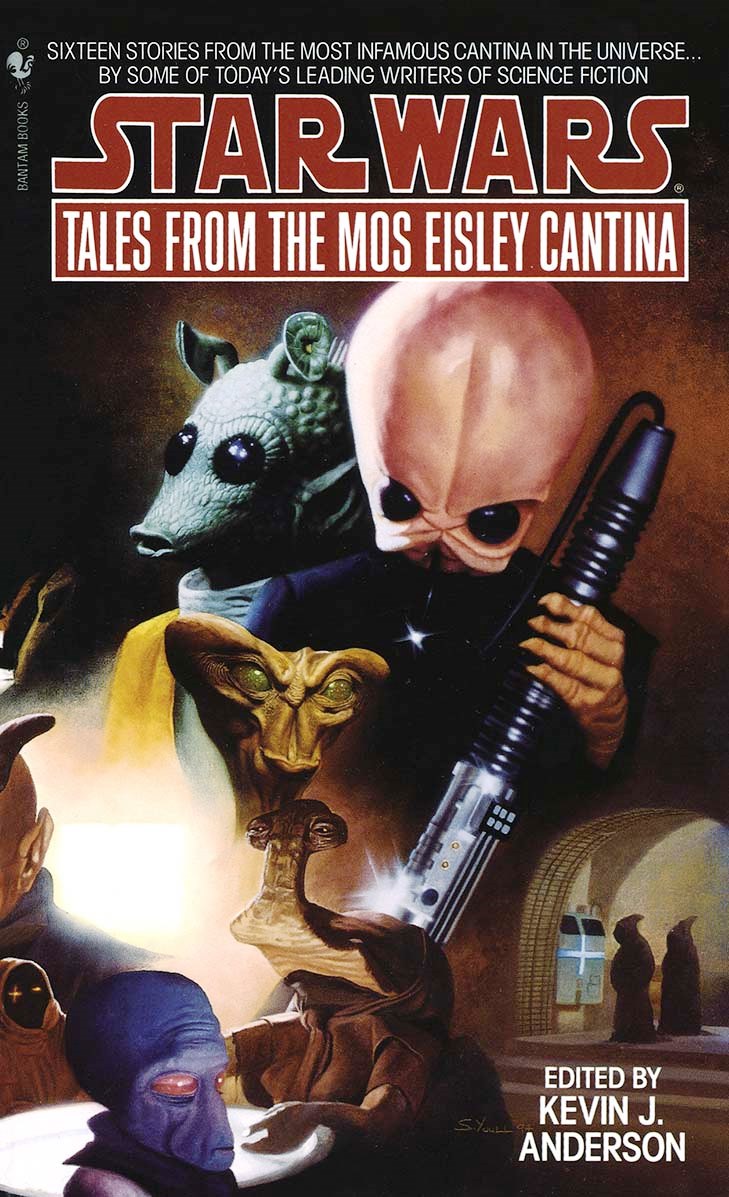
“A Hunter’s Fate” recounts Greedo’s childhood of isolation, persecution, and running from his clan’s tormentors. He is born on Rodia, to the wealthy bounty hunter, Greedo the Elder, and into the Tetsu Clan. His father’s rival, Navik the Red, murders the Greedo the Elder and subsumes the family wealth. Neela, the mother of Greedo the Young, the star of the story and this article, goes into hiding with her son and two hundred others of her clan. The junior Greedo is raised on the jungle planet U-Tendik, isolated and ignorant of not only the ways of the galaxy but of his family history, until Navik the Red comes calling again. Greedo, now a teenager, flees with the rest of his clan to the lawless “Smuggler’s Moon” Nar Shaddaa.
After learning his way around the underworld of Nar Shaddaa, Greedo and his family relocate again to the not-too-distant Tattooine. Settling into Mos Espa, Greedo becomes a petty criminal and thug, working his way up through low-level enforcing, to eventually hunt bounties for Jabba the Hutt, the crime lord of Tattooine.
“A Hunter’s Fate: Greedo’s Tale” has also been adapted to a visual medium in the form of the Web comic strip of the same title by Pablo Hidalgo. It was published in the members-only area of Hyperspace, the Official Star Wars Fan Club formerly housed at StarWars.com. Hyperspace was closed by LucasArts in 2011, though portions of the webstrip can be found around the Web.

If you want to indulge in role-playing a mistakenly self-professed great bounty hunter, or you want to try to redeem the defeasible Rodian, you can play him in the Star Wars: Battlefront video game and the Fantasy Flight tabletop game Star Wars: Imperial Assault. Greedo’s character card and miniature is available for Star Wars: Imperial Assault in the Greedo Villain Pack, with the paintable miniature depicting him frozen for all eternity in a slow-draw pose symbolic of the true circumstances of his demise.
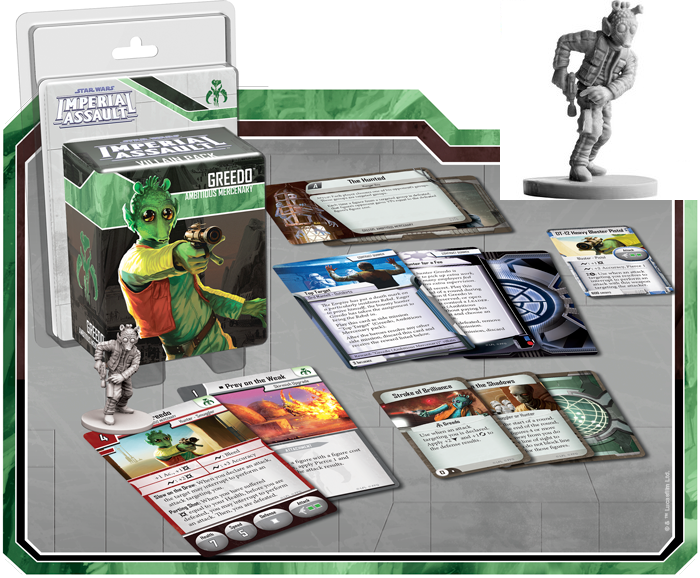
What in the Galaxy are those Symbols?
Throughout Who in the Galaxy is That? profiles you may encounter one or more of the following symbols.
Here’s what they mean:
 Canon
Canon- Sources and media cited as canon contain information that is officially part of the Star Wars film universe, which also includes non-film media such as books, comic books, games, and more. This means the information is officially part of the history of Star Wars that appears in the films. It came from, or may appear within or influence, the events of a Star Wars film.
 Legends
Legends- Following Return of the Jedi, George Lucas stated that he would not make other Star Wars movies. He then opened Star Wars to other creators and media. Carefully overseen by Lucas’s company, Lucas Arts, hundreds of new Star Wars novels, comic books and graphic novels, video games, and television shows were created to expand the Star Wars universe and tell stories in all directions—from thousands of years before Luke Skywalker was born to thousands of years after, from filling in the histories of the greatest Star Wars legends to bringing life to every background alien in the Cantina scene. This was the Star Wars Expanded Universe, and it was all canon until new Star Wars films were once again possible. Disney and Lucas Arts then found themselves penned in by the massive amount of material from other creators and projects. They simply couldn’t make Episode VII and beyond because every moment in the lives of the major characters of Han, Luke, Leia, and others had already been chronicled in the Expanded Universe, and very little of that could easily be translated to feature films easily followed by, and appealing to, the many different types of Star Wars fans who loved the Original Trilogy. As a result, a large portion of the formerly-canon Expanded Universe stories were declared non-canon, unofficial in terms of the film continuity. The stories still exist and continue to expand, but now in an alternate reality called Star Wars Legends while other new stories are created alongside them within the universe of the films.
 Fandom-Created
Fandom-Created- Though rare, you’ll see this symbol appear from time-to-time in Who in the Galaxy is That? Star Wars fans are many and varied, and they like to create their own movies, stories, comics, artwork, and more based in the Star Wars universe. Occasionally, a fan-created work is so good and becomes so popular that it gains super star status all on its own. When such rarities relate to the characters profiled in Who in the Galaxy is That?, they are identified by the Fandom-Created symbol.
Suggest a Character to Profile
Have you ever wondered, “who in the galaxy is that?” Tell us in the comments who you’ve wondered about in the Star Wars universe of films, books, comics, games, and even toys. If you know the character’s name, tell us, but if you don’t know a name, tell us where we can find the character that has piqued your curiosity. Something like “the third bounty hunter from the left in the Star Destroyer scene in Empire Strikes Back” works quite well in directing us to who you’re thinking about. Whomever you wonder about, we might just profile in Who in the Galaxy is That?
Hot Collectables


